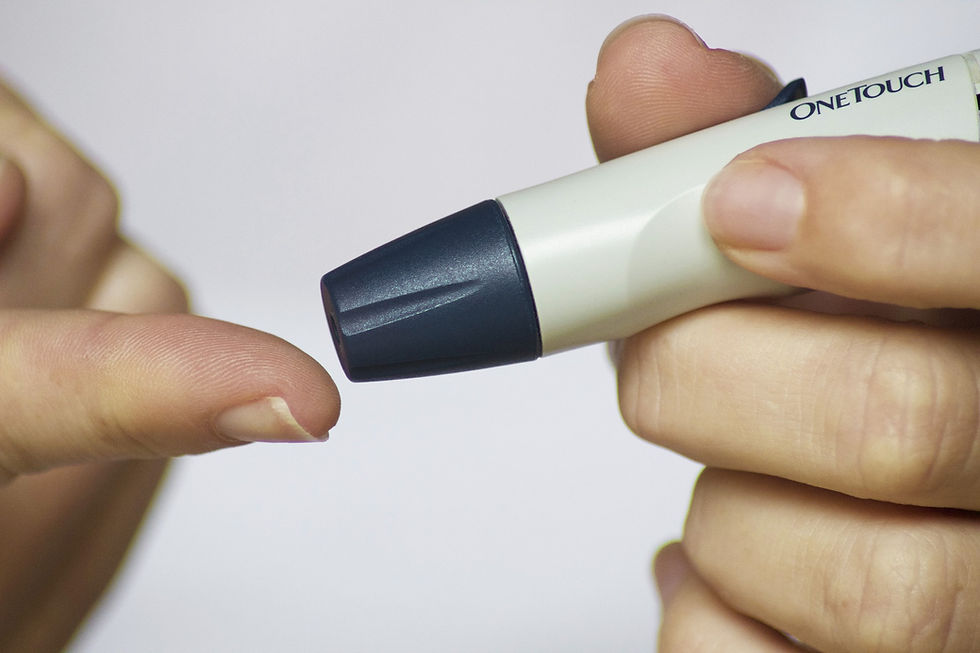Link between diabetes and heart disease
- Bolanle Aina PhD
- Feb 20, 2021
- 4 min read
Diabetes is a metabolic disorder characterized by high blood levels of sugar before and/or after eating. There are 2 main types of diabetes: Type 1 diabetes, which usually shows up at an early age and is due to inability of the body to produce insulin. Type 2 diabetes is more of an adult-onset disease and is due to inability of the body to respond to insulin and/or produce adequate amounts of insulin. Almost 90 % of diabetic cases fall into the Type 2 category. The prevalence of diabetes has increased dramatically in the United States in the past 2 decades partly due to diet, obesity and decreased physical activities. Other risk factors include family history, smoking, alcohol consumption, poor sleeping habits.

Diabetes symptoms and complications
At the onset, Type 2 diabetes usually may not cause any symptoms. But sometimes symptoms show up as frequent urination, excessive thirst and blurry vision. The best way to know is to contact your doctor to run a blood/urine test to check for elevated sugar levels. Uncontrolled diabetes is a risk factor for damage to other major organs such as the heart, kidney, eyes, and the nerves. In fact coronary heart disease such as heart attack and stroke is the leading cause of death among patients with diabetes mellitus. Untreated elevated blood sugar may promote heart attack and stroke by interfering with normal relaxation of blood vessels, increasing the risk of clot formation, and increased likelihood of fatty plaques in the blood vessels, which may all lead to restricted blood flow to vital body organs. When blood flow is restricted to the heart tissues, it causes heart attack -chest pain that may sometimes radiate to the left arm and the back. When blood flow is restricted to the brains it causes stroke - blurred vision, weakness and numbness on one side of the body.
Diabetes and Heart Failure
Diabetic patients are also at an increased risk of developing heart failure. Heart failure is not the same as cardiac arrest- a condition where the heart suddenly stops working. Heart failure is a condition in which the heart is unable to pump sufficient amount of blood to circulate round the various body organs. Symptoms of heart failure include fatigue, shortness of breath, cough, and in extreme cases, inability to perform day-to-day activities without running out of breath. Poor glucose control can lead to abnormal contraction and relaxation of the heart muscles as well as increased thickening of the heart muscle wall. This can result in poor circulation of blood in the body. There is also evidence to show that heart failure may cause diabetes, thus leading to a vicious cycle.

SGLT2 inhibitors (Jardiance and Forxiga) in Heart failure
Jardiance (empaglifloxin) belongs to the group of medications called SGLT2 (sodium glucose transporter 2) inhibitors. Other drugs that belong to this category of drugs that protect the heart include forxiga (dapaglifloxin) and Invokana (canaglifloxin). SGLT2 inhibitors are recommended for use in diabetic patients that also have heart issues. Jardiance and other medications in its category work by preventing the reabsorption of glucose in the kidney thus driving elimination of excess sugar out of the body through urine. Note that Jardiance may increase the risk of developing urinary tract infections due to increased sugar in the urinary tract. In a 2019 clinical study published in the New England Journal of Medicine, Forxiga was shown to lower the rate of cardiovascular death and hospitalization due to heart failure. In another 2020 clinical study, Forxiga was found to slow down kidney function decline in patients with chronic kidney disease with or without diabetes and reduced deaths from kidney or heart disease.
Another interesting potential use that has recently popped up for Jardiance is in the treatment of some patients with heart failure without diabetes. In the 2020 clinical study, Jardiance, in addition to standard therapy, reduced the risk of cardiovascular death or hospitalization in heart failure patients regardless of whether they are diabetic or not. In order to confirm the benefit of Jardiance in non-diabetic heart failure patients, a recent 2021 study published in the Journal of American College of Cardiology shows that indeed Jardiance, in addition to standard therapy, improved quality of life and ability of the heart to contract and relax in non-diabetic heart failure patients. The exact mechanism for the protective effect on the heart is still not fully understood and more research is underway to understand the role of SGLT2 inhibitors on the heart apart from glucose lowering effects.






Comentarios